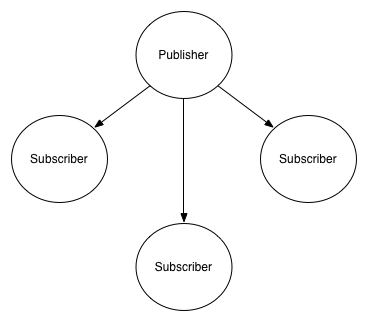在众多消息队列中,最简单、灵活、快速的应该就是 nanomsg 吧,
nanomsg 是 zeromq 作者重新用 C 语言重新实现的,
是对 zeromq 的经验教训的各种提炼和反思。
We add power by removing complexity rather than exposing new functionality.
-- zeromq doc
nanomq 提供了 6 种通信模式,也即所谓“扩展性协议”:
- pipeline
- reqrep
- pair
- bus
- pubsub
- survey
这些扩展性协议是建立在传输层之上的,现在 nanomsg 提供了 3 种传输机制:
- inproc(单进程内通信)
- ipc(单机内多进程通信)
- tcp(通过 tcp 协议的网络通信)
nanomsg 的所有操作都是基于不同类型的 Socket,而 Socket 的类型决定了 nanomsg 使用了哪种通信模式和传输机制。
以下示例用 python 语言编写。
安装 nanomsg
sudo pacman -S nanomsg
Pipeline(A One-Way Pipe)

文件 pipeline.py 如下:
import nnpy
def producer(url, msg):
sock = nnpy.Socket(nnpy.AF_SP, nnpy.PUSH)
sock.bind(url)
print(f'[Producer]: send "{msg}"')
sock.send(msg)
def consumer(url):
sock = nnpy.Socket(nnpy.AF_SP, nnpy.PULL)
sock.connect(url)
while True:
msg = sock.recv()
print(f'[Consumer]: receive "{msg}"')
if __name__ == '__main__':
import sys
assert len(sys.argv) >= 2
if sys.argv[1] == 'producer':
assert len(sys.argv) == 4
producer(sys.argv[2], sys.argv[3])
elif sys.argv[1] == 'consumer':
assert len(sys.argv) == 3
consumer(sys.argv[2])
else:
print('''Usage:
python pipeline.py producer <url> <msg>
python pipeline.py consumer <url>''')
终端测试:
# 终端1
python pipeline.py consumer 'ipc:///tmp/pipeline.ipc'
# 终端2
python pipeline.py producer 'ipc:///tmp/pipeline.ipc' 'hello world'
Request/Reply (I ask, you answer)

文件 reqrep.py 如下:
import nnpy
def server(url):
sock = nnpy.Socket(nnpy.AF_SP, nnpy.REP)
sock.bind(url)
while True:
msg = sock.recv()
print(f'[Server]: received "{msg}"')
sock.send(msg)
print(f'[Server]: sent "{msg}"')
def client(url, msg):
sock = nnpy.Socket(nnpy.AF_SP, nnpy.REQ)
sock.connect(url)
print(f'[Client]: send "{msg}"')
sock.send(msg)
msg = sock.recv()
print(f'[Client]: received "{msg}"')
if __name__ == '__main__':
import sys
assert len(sys.argv) >= 2
if sys.argv[1] == 'server':
assert len(sys.argv) == 3
server(sys.argv[2])
elif sys.argv[1] == 'client':
assert len(sys.argv) == 4
client(sys.argv[2], sys.argv[3])
else:
print('''Usage:
python reqrep.py server <url>
python reqrep.py client <url> <msg>''')
终端测试:
# 终端1
python reqrep.py server 'ipc:///tmp/reqrep.ipc'
# 终端2
python reqrep.py client 'ipc:///tmp/reqrep.ipc' 'hello world'
Pair (Two Way Radio)

文件 pair.py 如下:
import time
import nnpy
def node1(url):
sock = nnpy.Socket(nnpy.AF_SP, nnpy.PAIR)
sock.bind(url)
name = 'Node1'
while True:
msg = sock.recv()
print(f'[{name}] received {msg}')
time.sleep(1)
print(f'[{name}] send {name}')
sock.send(name)
def node2(url):
sock = nnpy.Socket(nnpy.AF_SP, nnpy.PAIR)
sock.connect(url)
name = 'Node2'
while True:
print(f'[{name}] send {name}')
sock.send(name)
time.sleep(1)
msg = sock.recv()
print(f'[{name}] received {msg}')
if __name__ == '__main__':
import sys
assert len(sys.argv) == 3
if sys.argv[1] == 'node1':
node1(sys.argv[2])
elif sys.argv[1] == 'node2':
node2(sys.argv[2])
else:
print('''Usage:
python pair.py node1 <url>
python pair.py node1 <url>''')
终端测试:
# 终端1
python pair.py node1 'ipc:///tmp/pair.ipc'
# 终端2
python pair.py node2 'ipc:///tmp/pair.ipc' 'hello world'
Pub/Sub (Topics & Broadcast)

文件 pubsub.py 如下:
import time
import nnpy
def publisher(url):
sock = nnpy.Socket(nnpy.AF_SP, nnpy.PUB)
sock.bind(url)
while True:
msg = str(time.time())
print(f'[Publisher] publish {msg}')
sock.send(msg)
time.sleep(1)
def subscriber(url, name):
sock = nnpy.Socket(nnpy.AF_SP, nnpy.SUB)
sock.setsockopt(nnpy.SUB, nnpy.SUB_SUBSCRIBE, "")
sock.connect(url)
while True:
msg = sock.recv()
print(f'[{name}] received {msg}')
if __name__ == '__main__':
import sys
assert len(sys.argv) == 3
if sys.argv[1] == 'publisher':
publisher(sys.argv[2])
elif sys.argv[1].startswith('subscriber'):
subscriber(sys.argv[2], sys.argv[1])
else:
print('''Usage:
python pubsub.py publisher <url>
python pubsub.py subscriber<n> <url>''')
终端测试:
# 终端1
python pubsub.py publisher 'ipc:///tmp/pubsub.ipc'
# 终端2
python pubsub.py subscriber1 'ipc:///tmp/pubsub.ipc'
# 终端3
python pubsub.py subscriber2 'ipc:///tmp/pubsub.ipc'
# 终端4
python pubsub.py subscriber3 'ipc:///tmp/pubsub.ipc'
Survey (Everybody Votes)

文件 survey.py 如下:
import time
import nnpy
def surveyor(url):
sock = nnpy.Socket(nnpy.AF_SP, nnpy.SURVEYOR)
sock.bind(url)
time.sleep(1)
msg = str(time.time())
print(f'[Surveyor] request {msg}')
sock.send(msg)
while True:
try:
msg = sock.recv()
print(f'[Surveyor] receive {msg}')
except nnpy.errors.NNError:
break
def respondent(url, name):
sock = nnpy.Socket(nnpy.AF_SP, nnpy.RESPONDENT)
sock.connect(url)
while True:
msg = sock.recv()
print(f'[{name}] received {msg}')
print(f'[{name}] response {msg}')
sock.send(msg)
if __name__ == '__main__':
import sys
assert len(sys.argv) == 3
if sys.argv[1] == 'surveyor':
surveyor(sys.argv[2])
elif sys.argv[1].startswith('respondent'):
respondent(sys.argv[2], sys.argv[1])
else:
print('''Usage:
python survey.py surveyor <url>
python survey.py respondent<n> <url>''')
终端测试:
# 终端1
python survey.py respondent1 'ipc:///tmp/survey.ipc'
# 终端2
python survey.py respondent2 'ipc:///tmp/survey.ipc'
# 终端3
python survey.py respondent3 'ipc:///tmp/survey.ipc'
# 终端4
python survey.py surveyor 'ipc:///tmp/survey.ipc'
Bus (Routing)

文件 bus.py 如下:
import time
import nnpy
def node(url, name, *other_urls):
sock = nnpy.Socket(nnpy.AF_SP, nnpy.BUS)
sock.bind(url)
for url in other_urls:
sock.connect(url)
time.sleep(5)
sock.setsockopt(nnpy.SOL_SOCKET, nnpy.RCVTIMEO, 5000)
print(f'[{name}] send {name} onto bus')
sock.send(name)
while True:
try:
msg = sock.recv()
print(f'[{name}] receive {msg} from bus')
except nnpy.errors.NNError:
break
if __name__ == '__main__':
import sys
assert len(sys.argv) >= 4
if sys.argv[1].startswith('node'):
node(sys.argv[2], sys.argv[1], *sys.argv[3:])
else:
print('''Usage:
python bus.py node<n> <url> <url>...''')
终端测试:
# 终端1
python bus.py node1 'ipc:///tmp/node1.ipc' \
'ipc:///tmp/node2.ipc' \
'ipc:///tmp/node3.ipc' \
'ipc:///tmp/node4.ipc'
# 终端2
python bus.py node2 'ipc:///tmp/node2.ipc' \
'ipc:///tmp/node1.ipc' \
'ipc:///tmp/node3.ipc' \
'ipc:///tmp/node4.ipc'
# 终端3
python bus.py node3 'ipc:///tmp/node3.ipc' \
'ipc:///tmp/node1.ipc' \
'ipc:///tmp/node2.ipc' \
'ipc:///tmp/node4.ipc'
# 终端4
python bus.py node4 'ipc:///tmp/node4.ipc' \
'ipc:///tmp/node1.ipc' \
'ipc:///tmp/node2.ipc' \
'ipc:///tmp/node3.ipc'